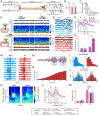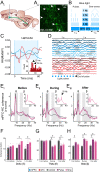Nucleus reuniens transiently synchronizes memory networks at beta frequencies
- PMID: 37468487
- PMCID: PMC10356781
- DOI: 10.1038/s41467-023-40044-z
Nucleus reuniens transiently synchronizes memory networks at beta frequencies
Abstract
Episodic memory-based decision-making requires top-down medial prefrontal cortex and hippocampal interactions. This integrated prefrontal-hippocampal memory state is thought to be organized by synchronized network oscillations and mediated by connectivity with the thalamic nucleus reuniens (RE). Whether and how the RE synchronizes prefrontal-hippocampal networks in memory, however, remains unknown. Here, we recorded local field potentials from the prefrontal-RE-hippocampal network while rats engaged in a nonspatial sequence memory task, thereby isolating memory-related activity from running-related oscillations. We found that synchronous prefrontal-hippocampal beta bursts (15-30 Hz) dominated during memory trials, whereas synchronous theta activity (6-12 Hz) dominated during non-memory-related running. Moreover, RE beta activity appeared first, followed by prefrontal and hippocampal synchronized beta, suggesting that prefrontal-hippocampal beta could be driven by the RE. To test whether the RE is capable of driving prefrontal-hippocampal beta synchrony, we used an optogenetic approach (retroAAV-ChR2). RE activation induced prefrontal-hippocampal beta coherence and reduced theta coherence, matching the observed memory-driven network state in the sequence task. These findings are the first to demonstrate that the RE contributes to memory by driving transient synchronized beta in the prefrontal-hippocampal system, thereby facilitating interactions that underlie memory-based decision-making.
© 2023. The Author(s).
Conflict of interest statement
The authors declare no competing interests.
Figures




Similar articles
-
Ventral Midline Thalamus Is Critical for Hippocampal-Prefrontal Synchrony and Spatial Working Memory.J Neurosci. 2016 Aug 10;36(32):8372-89. doi: 10.1523/JNEUROSCI.0991-16.2016. J Neurosci. 2016. PMID: 27511010 Free PMC article.
-
Cell Assemblies in the Cortico-Hippocampal-Reuniens Network during Slow Oscillations.J Neurosci. 2020 Oct 21;40(43):8343-8354. doi: 10.1523/JNEUROSCI.0571-20.2020. Epub 2020 Sep 29. J Neurosci. 2020. PMID: 32994338 Free PMC article.
-
Transient inactivation of the thalamic nucleus reuniens and rhomboid nucleus produces deficits of a working-memory dependent tactile-visual conditional discrimination task.Behav Neurosci. 2013 Dec;127(6):860-6. doi: 10.1037/a0034653. Behav Neurosci. 2013. PMID: 24341710 Free PMC article.
-
The nucleus reuniens orchestrates prefrontal-hippocampal synchrony during spatial working memory.Neurosci Biobehav Rev. 2021 Sep;128:415-420. doi: 10.1016/j.neubiorev.2021.05.033. Epub 2021 Jul 1. Neurosci Biobehav Rev. 2021. PMID: 34217746 Free PMC article. Review.
-
The nucleus reuniens, a thalamic relay for cortico-hippocampal interaction in recent and remote memory consolidation.Neurosci Biobehav Rev. 2021 Jun;125:339-354. doi: 10.1016/j.neubiorev.2021.02.025. Epub 2021 Feb 22. Neurosci Biobehav Rev. 2021. PMID: 33631314 Review.
Cited by
-
Medial prefrontal cortex to nucleus reuniens circuit is critical for performance in an operant delayed nonmatch to position task.Neurobiol Learn Mem. 2025 Jan;217:108007. doi: 10.1016/j.nlm.2024.108007. Epub 2024 Nov 23. Neurobiol Learn Mem. 2025. PMID: 39586458
-
Distinct functions for beta and alpha bursts in gating of human working memory.Nat Commun. 2024 Oct 17;15(1):8950. doi: 10.1038/s41467-024-53257-7. Nat Commun. 2024. PMID: 39419974 Free PMC article.
-
Deliberative Behaviors and Prefrontal-Hippocampal Coupling are Disrupted in a Rat Model of Fetal Alcohol Spectrum Disorders.bioRxiv [Preprint]. 2024 Jul 29:2024.07.28.605480. doi: 10.1101/2024.07.28.605480. bioRxiv. 2024. Update in: J Neurosci. 2025 Mar 05;45(10):e1241242025. doi: 10.1523/JNEUROSCI.1241-24.2025. PMID: 39131304 Free PMC article. Updated. Preprint.
-
A thalamic-hippocampal CA1 signal for contextual fear memory suppression, extinction, and discrimination.Nat Commun. 2023 Oct 24;14(1):6758. doi: 10.1038/s41467-023-42429-6. Nat Commun. 2023. PMID: 37875465 Free PMC article.
-
Choice Behaviors and Prefrontal-Hippocampal Coupling Are Disrupted in a Rat Model of Fetal Alcohol Spectrum Disorders.J Neurosci. 2025 Mar 5;45(10):e1241242025. doi: 10.1523/JNEUROSCI.1241-24.2025. J Neurosci. 2025. PMID: 39900497
References
Publication types
MeSH terms
Grants and funding
LinkOut - more resources
Full Text Sources

